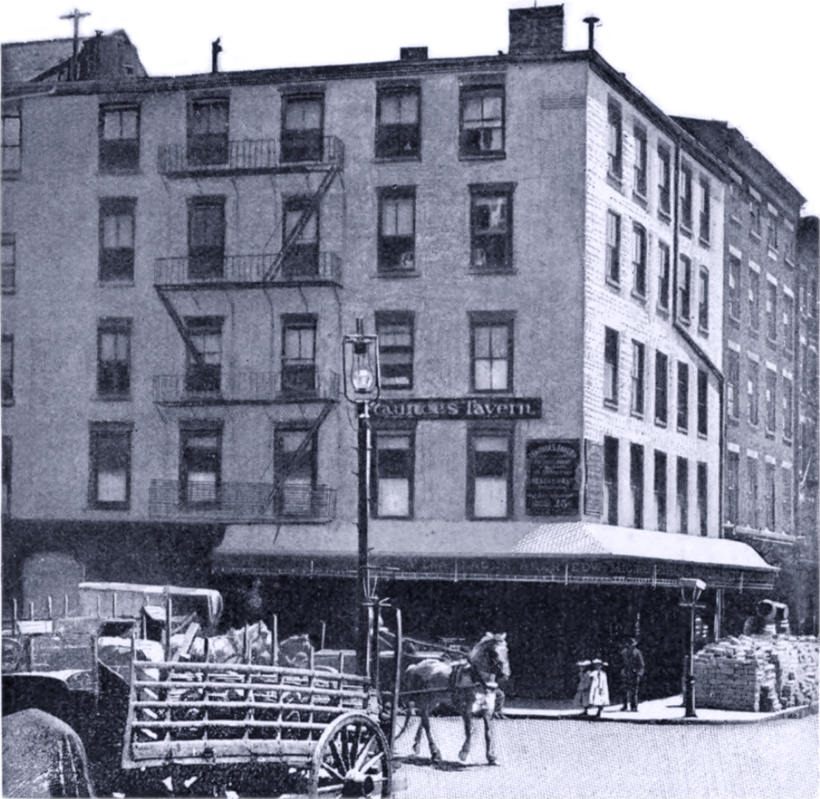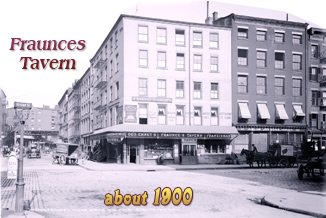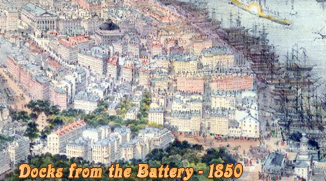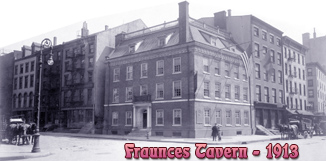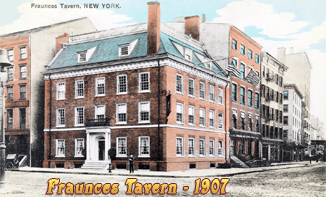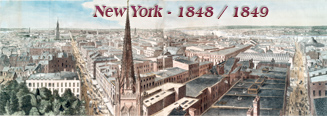The Fraunces Tavern,
at 54 Pearl Street,
in photo published in the Harper's Weekly, November 7, 1896. The Edw.
Michels Hotel operated in the building.
At the time, the building had a "Fraunce's Tavern" sign on the Pearl St. front. It replaced the old signs of "Washington's Head Quarters". Later, another sign of "Fraunce's Tavern" was placed on the Broad St. front.
The building was originally constructed in 1719 as a residence for de Lancey family. Samuel Fraunces owned the property from 1762 to 1785 and operated a tavern on the place.
Below, part of the text published in the Harper's Weekly:
Fraunces' Tavern, still standing and in use on the southeast corner of Broad and Pearl streets, is now, with little doubt, the oldest building in the city, and perhaps one could have no more fitting reminder of the New York of a century and a quarter ago. It was then the social headquarters of the city, and here its leading men gathered of a Saturday evening in winter and enjoyed themselves, after the hearty, generous fashion of the olden time, until the coming of the Revolution brought more serious days, and scattered them to the four quarters of the compass -some to swell the ranks of the Royalist exiles in Nova Scotia and England; others to take service in the patriot army; and not a few to serve the cause of the King as best they could within the British lines on Long Island.
In 1762, the house passed into the ownership of Samuel Fraunces, whose name has ever since clung to it. Fraunces was easily the hest-known publican of his time, a native of the French West Indies, and by reason of his swarthy complexion popularly known as Black Sam. Tradition has it that he was a splendid cook, and a restless, venturesome fellow as well. He did not long remain content with his new venture, and from 1765 to 1770 leased it in turn to John Jones and Bolton & Sigell. It was during the tenancy of the latter, in 1768, to be exact, that the New York Chamber of Commerce was instituted in the Long Room of the tavern, and here its monthly evening sessions were held until permanent quarters were found for it in the Merchants' Exchange, close at hand. In 1770 Fraunces, who had meanwhile conducted the Vauxhall, a summer garden on the Hudson at the foot of Warren Street, resumed the management of his hostelry. "The Queen's Head "―so runs his naive announcement in Holt's New York Journal of September 13, 1770 ― "for many years past kept by the subscriber, is now fitting up in the most genteel and convenient manner for the reception and entertainment of those gentlemen, ladies, and others who may favor him with their company. As the best clubs and the greatest entertainments in this city were at the above tavern in the time of the subscriber, he flatters himself the public are so well satisfied of his ability to serve them as to render the swelling of an advertisement useless, other than to assure his former friends and the public in general that every endeavor will be used to give them the highest satisfaction and the utmost respect on all occasions shown by their already much obliged and very obedient servant, Samuel Fraunces."
Fraunces seems to have kept his word, and stately John Hancock, President of the Second Continental Congress, in 1775, in a letter to his intended wife, Dorothy Quincy, describing his entrance from the King's Bridge into the city of New York ― he was then on his way from his home in Massachusetts to attend the opening of the Congress in Philadelphia ― says they were "set down at Fraunces' Tavern amid the acclamations of thousands." In August, 1775, when the cannon were removed from the Battery by the Sons of Liberty, the angry commander of the British man-of-war Asia fired upon the city, and one of the balls lodged in the roof of the tavern. Fraunces, however, did not complain at this, for he was a stanch friend of the patriot cause, and played a worthy, if modest, part in the stirring events of the time. In 1776 he went out with the patriots, but seems later to have returned to the city, perhaps by British permission, under arrangement with Washington, and to have resided there during at least part of the British occupation, as his generous advances to the American prisoners at that time confined in the city prompted a vote of thanks and a handsome grant of money from Congress. It was in the Long Room of Fraunces' Tavern that, at the close of the military movements attending the taking possession of the city on the evacuation by the British, November 25, 1783, Governor Clinton gave a dinner to the commander-in-chief and other general officers of the patriot forces, but the event by reason of which this famous old inn will always claim a place in our history occurred nine days later, when, on December 4, 1783, in this same Long Room, Washington took touching and solemn farewell of his generals before departing upon his journey to Annapolis, where he surrendered his commission to Congress. Mine host Fraunces was not forgotten in the bestowal of rewards which followed the success of the patriot cause and the founding of the republic. When, in 1789, Washington returned to New York to be inaugurated President of the United States and took up his residence here, he made Fraunces steward of his household, a post for which the latter was admirably fitted, and which he filled to the satisfaction of all concerned; and so his humble name has a place in our annals side by side with that of his great patron.
Fraunces' Tavern was originally three stories high, a lofty building for those early days, and built of brick brought from Golden's yard in Amsterdam. It is still a public house, and has never been otherwise since it was first opened for that purpose. In 1853 [1852] a fire visited the building. In the repairs made at that time the Dutch roof surmounting the house was torn down and replaced by two additional flat-topped stories. The lower floor of the house retained its original shape until 1890, when the old walls were torn down and replaced by a pretentious stone front, and the old tap room, scene of so many merry gatherings in the vanished days, was converted into a modern bar-room. Fortunately, however, these modern improvements stopped short of the Long Room, on the second floor. This is an apartment forty-three feet in length and twenty in width. Its walls are hung with a picture of the old tavern, a faded and time-worn copy of the Declaration of Independence, a portrait of Washington, and other articles eloquent of the history and associations of the place. Save for the paper on the walls and the laying of a new floor, the Long Room has not been changed since Washington stood there. The old wall-cupboard still stands, and just across the narrow hallway is the old kitchen, improved by the introduction of a modern range, but otherwise unchanged. On the third floor are several small rooms built for guests of the tavern, rarely used at present, but which, except as to furniture, stand just as they did a hundred years ago.
